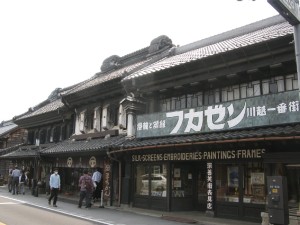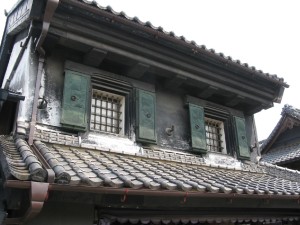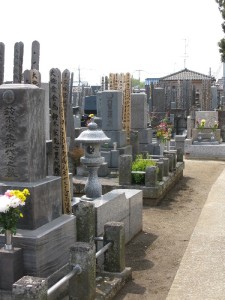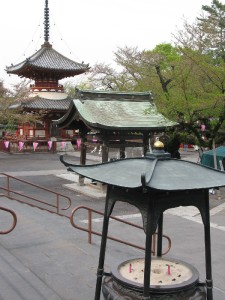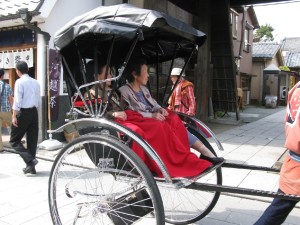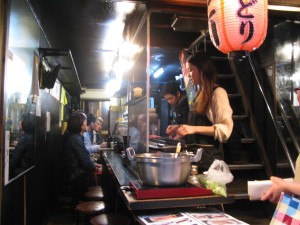Wednesday was sunny too, so we made an effort to get out early and headed for Seibu Shinjuku station and one of the many private suburban railways that serve Tokyo. The train was slow, stopping at every station, but after a while the high rises petered out, and eventually we even saw individual houses with gardens. After an hour a few fields appeared, and then we were at Kawagoe.
People go to Kawagoe to see the kind of historical buildings that Tokyo lacks. The old part is only a few streets, with most of the old buildings converted into shops selling upmarket tourist oriented goods, but it was attractive. It was the Japanese equivalent of a Cotswold market town really.
Candy Street is almost exclusively devoted to shops selling sweets and packaged snacks and it didn’t detain us long – more interesting was the cemetary that we stumbled across by chance. It was immaculately kept, and many of the polished granite memorials held fresh flowers. Beside each one were a number of flat wooden sticks, placed as memorial markers on anniversaries of the individual’s death. Incense smoke drifted across the graves from burnerers near the entrance. It was very peaceful there – so quiet compared with Tokyo. On the way out we noticed a utility area with brushes, dustpans, sinks and electric gadgets for lighting bundles of incense sticks, all just left out for people to use. No thought that they’d be stolen.
Back on the main road we rested on seats outside row of snack shops, and tasted a sample of the roasted sweet potato for which Kawagoe is famous. I can’t say I was hooked. We popped into the shrine by the Toki no Kane bell tower, then made our way to the Katien temple. This temple has a walled area with lots of bodhisattva statues, but we contended ourselves with viewing them from the gate rather than paying the entrance fee. Otherwise there was nothing special about the temple. It was nice to be in a little town though, and I was pleased when my stumbling Japanese request for directions back to the station was understood.
As waited for our train a woman came and sat nearby. To my alarm I saw that she was bleeding copiously from a head wound; I assume she must have fallen over. The injury was not actually that bad (I remember a first aid trainer telling me that scalp wounds often look worse than they are) so I tried to clean her up as best I could with tissues and bottled water. Eventually station employees arrived with a wheelchair and took her away. We wanted to get the express train back – it was a different colour train and we had to get a ticket from a machine before we were allowed to board. But we’d already swiped our Pasmo cards on the way into Kawagoe station, so when we got to the other end we had to get the ticket inspector to reset them before we could top them up. Not an easy thing to explain in sign language!
As it was still fairly early we detoured to a camera shop as Mr Vagabond was considering getting a new one. On the way home we cut through a narrow lane by Shinjuku station that was lined with tiny bars, each just wide enough for a bar and a row of stools, filled with groups of office workers drinking beer and chewing on skewers of meat. The lights were just coming on and the alley was hazy with the smoke from the grills. In a vast and often impersonal city it was a warm and cozy scene.


